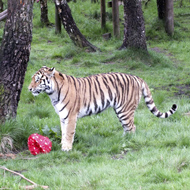Stylish first birthday celebrations for tiger cubs

Highland Wildlife Park is celebrating the first birthday of Scotland’s only Amur tiger cubs, Murray and Viktor.
Amur tigers, the largest members of the cat family, are listed as endangered on the IUCN Red list, with only 350-450 individuals left in the wild. The birth of Murray and Viktor was good news in terms of the species’ conservation, and they became the Parks two biggest celebrities with their arrival attracting a record number of visitors.
The young tigers, named after the historic Wimbledon tennis victor Andy Murray, will be celebrating in style with tennis-themed treats arranged by the Park’s keepers.
Several large, tiger-friendly strawberry shaped piñatas will be hung in the tiger cubs’ enclosure, to reflect the Wimbledon association with strawberries and cream. Filled with bison scented straw and small pieces of meat, the strawberries will be a tempting treat for the cubs and their parents Dominika and Marty, encouraging them to climb and jump to rip into their strawberries.
They may have come a long way since they were first sighted as tiny bundles of fur last year, but the cubs will not reach adulthood until they are four-years-old, and they still exhibit a mischievous and playful nature.
The Head Carnivore Keeper for Highland Wildlife Park, Una Richardson, said:
“Murray and Viktor certainly have a special place in our hearts – they are the second generation of cubs to be born at the Park, with their mother Dominika born here only five years prior. They also act as great ambassadors for conservation, providing us with the opportunity to tell visitors about the threats faced by their wild counterparts, the efforts being made to save tigers from extinction and draw comparisons with the equally threatened Scottish wildcat.”
Image courtesey of the Royal Zoological Society of Scotland.



 The BSAVA has opened submissions for the BSAVA Clinical Research Abstracts 2026.
The BSAVA has opened submissions for the BSAVA Clinical Research Abstracts 2026.